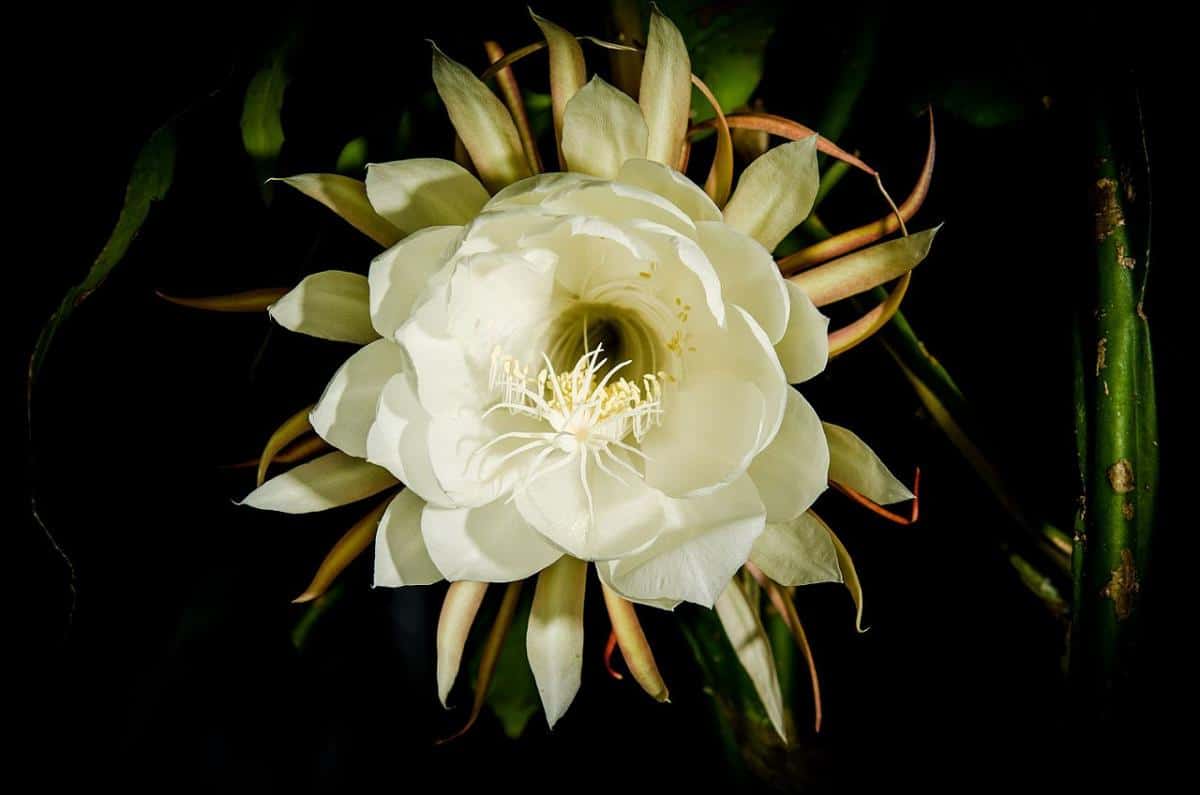
Image - Wikimedia / Cristóbal Alvarado Minic
Cacti of the genus Epiphyllum They are characterized by many things, but above all by their magnificent flowers. These are large, generally white, and have a very limited life expectancy.
They are fast growing plants, which they are ideal for growing in a large pot, or in the trunk of a tree. Of course, they have a drawback and that is that they do not resist much the cold. But even that can be easily solved by putting them indoors.
Origin and characteristics of the Epiphyllum
The Epiphyllum are epiphytic cacti native to Central America known as cactus orchids or lady of the night. The genus is made up of about 19 species popularly called orchid cactus. They develop elongated and almost flat stems 1 to 5 centimeters wide by 3 to 5 millimeters thick.
Y its flowers are between 8 and 20 centimeters in diameter. These open at night, and can be white or red. The fruit is edible, but it is only about 4 centimeters long. It contains numerous small, blackish seeds.
Main species
Of the almost twenty species of Epiphyllum that have been described, the reality is that only a few have commercial interest, and they are:
Epiphyllum anguliger

Image - Wikimedia / Zapyon
El Epiphyllum anguliger it is an endemic species of Mexico, with highly branched and lobed stems. Each stem segment is approximately 30 centimeters long by 3-5 centimeters wide. Its flowers are between 6 and 7 centimeters wide, and are yellow, green or pink.. The fruit is ovoid, green, yellowish or brown and measures 3-4 centimeters.
Epiphyllum crenatum

Image - Wikimedia / Sadambio
El Epiphyllum crenatum It is the species from which the great majority, if not all, of the Epiphyllum hybrids that are commercialized come from. Its stems are flat and measure up to 60 centimeters long by 6-10 centimeters wide. The flowers are white and large, since they measure 15-20 centimeters in diameter.
Epiphyllum oxypetalum

Image - Wikimedia / Alastair Woods Photography
El Epiphyllum oxypetalum It is a native species of Central America, with stems about 40 centimeters long by 1-10 centimeters wide. It produces white and scented flowers up to 25 centimeters in diameter, and ovoid-shaped red fruits.
Epiphyllum pumilum

Image - Flickr / epiforums
El Epiphyllum pumilum it is a natural species of Mexico, Belize and Guatemala. It develops a primary stem up to 150 centimeters long, and other secondary ones between 10 and 60 centimeters long. The flowers are between 10 and 15 centimeters in diameter, white and fragrant. The fruit is about 2,5 centimeters thick.
What are the care that must be given to them?
The Epiphyllum are cacti that grow well in places where there is a lot of natural light, and where they are protected from low temperatures. As they are tropical plants, it is important to avoid exposing them to cold and, above all, to frost.
In any case, below we tell you what are the basic care that we recommend providing them:
Location
The Epiphyllum They must be in a bright area, but it does not have to shine directly on them. The best plants are those that are in semi-shade, and those that receive filtered light.
Earth
- Flower pot: it has to be filled with substrate for cacti, or else make a mixture with peat and perlite (for sale here) with a little worm castings in equal parts.
- Garden: the soil must be light, and it must also have good drainage. There is no worse for Epiphyllum than growing on compact soils, since in them the roots cannot breathe normally.
Irrigation
They have to be watered an average of 2 times a week in summer, and 1-2 a week the rest of the year. It is advisable to use rainwater whenever possible, but if it rains little in your area, you can use any as long as it is soft.
Anyway, when you water you don't have to wet the cactus, only the soil. That is, you have to water from above, and not below or by immersion. It should only be watered from below if the soil is very, very dry, and you see that when you pour water into it, it is not absorbed.
Subscriber

Image - Wikimedia / Jim Evans
The Epiphyllum must be paid from March / April to September / October in the northern hemisphere, coinciding with spring and summer. It could even be until November in places where there may be frosts but they are weak and late (January / February), as for example in the Mediterranean region.
What to use to pay? Well, since the fruits can be eaten, we recommend using fertilizers authorized for organic farming, and these are: manure, guano, worm humus (for sale here), ... and any other that comes from animals and / or vegetables, such as seaweed extract (although if you are going to use this, use it in moderation as it is very alkaline).
Multiplication
These plants multiply by cuttings and by seeds in spring:
- Cuttings: the desired stem segments are cut and planted in individual pots with cactus soil. To get them to root faster it is possible to impregnate the base with rooting hormones, but they are not really necessary. They will have their first roots after approximately 14 days.
- Seeds: the seeds are sown in pots with soil for cacti (for sale here), and are left in a bright place, near a heat source. They will germinate in about ten days.
Rusticity
They are sensitive to cold. The minimum temperature they support is 5ºC.
What do you think of the Epiphyllum?
The info is very interesting!
Thank you Mercedes 🙂